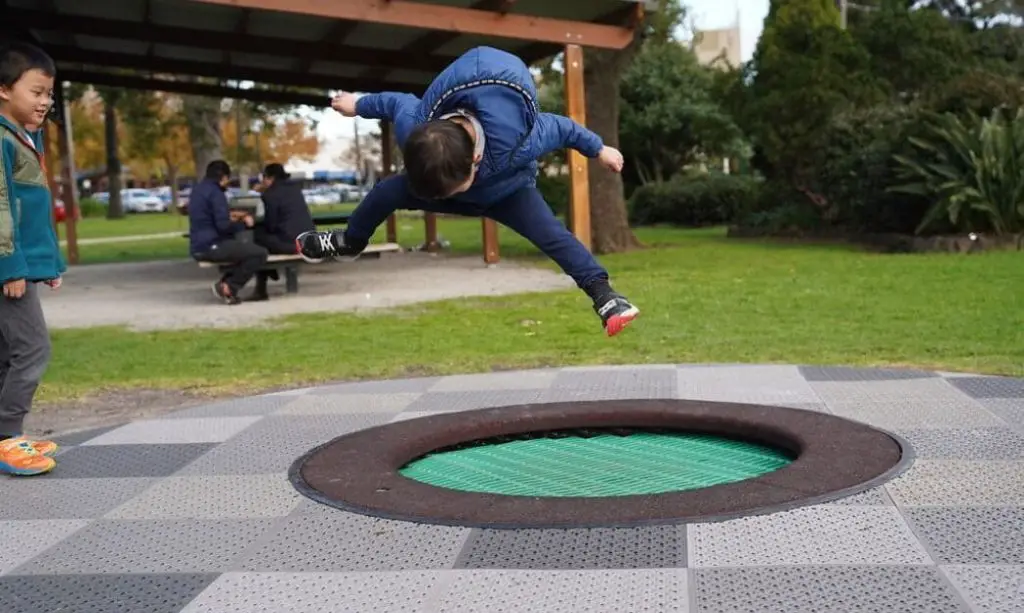Trampoline exercise is a popular form of exercise that has been gaining popularity in recent years. Not only is it a fun and exciting way to work out, but it also offers numerous health benefits.
From improving cardiovascular fitness to strengthening muscles and improving coordination, trampoline exercise has something to offer everyone.
One of the great things about trampoline exercise is that it can be a low-impact way to get your heart rate up and improve circulation without putting too much strain on your joints.
In addition, the act of jumping on a trampoline can help improve balance and coordination, as well as strengthen the muscles in your legs and core.
Whether you’re a beginner or an experienced athlete, there are plenty of ways to incorporate trampoline exercise into your routine and enjoy all of its benefits.
In this article, we will explore the various benefits of trampoline exercise and how to get started with this fun and effective form of exercise.
Trampoline Exercise Benefits: Trampoline exercise offers a fun and effective way to improve cardiovascular fitness, strengthen muscles, and improve coordination. Whether you’re a beginner or an experienced athlete, there are plenty of ways to incorporate trampoline exercise into your routine and enjoy all of its benefits.
What is Trampoline Exercise?
Trampoline exercise refers to physical activities and workouts performed on a trampoline, which is a flexible, spring-supported device consisting of a strong fabric sheet or mat attached to a sturdy frame.
Trampolines are designed to allow individuals to bounce and jump on the surface, utilizing the elasticity of the fabric and springs to propel themselves into the air.
Trampoline Exercise Benefits

Trampoline exercise is a popular form of physical activity that offers a wide range of health benefits. Whether you are a beginner or an experienced athlete, trampoline exercise can help you achieve your fitness goals while improving your overall health and well-being.
Weight loss and fitness:
One of the most well-known benefits of trampoline exercise is weight loss and fitness. Trampoline exercise is a high-intensity workout that can burn a significant number of calories.
According to research, a 30-minute trampoline session can burn up to 200-240 calories, which is comparable to jogging or cycling.
The science behind this benefit is that trampoline exercise engages multiple muscle groups simultaneously, which requires more energy and burns more calories.
Additionally, the bouncing motion of the trampoline creates an unstable surface, which forces your body to work harder to maintain balance and stability.
Improved balance:
Trampoline exercise can also improve your balance and coordination. This is because trampolining requires you to maintain control of your body while bouncing and performing various movements.
Over time, this can improve your proprioception, which is your body’s ability to sense its position and movements in space.
The science behind this benefit is that trampoline exercise activates your vestibular system, which is responsible for maintaining balance and spatial orientation.
The repeated bouncing and changes in direction stimulate the fluid-filled canals in your inner ear, which sends signals to your brain to help you maintain balance.
Joint and bone health:
Trampoline exercise is a low-impact workout that can help improve joint and bone health. Unlike running or other high-impact exercises, trampolining puts less stress on your joints and bones, which reduces the risk of injury and can help alleviate joint pain.
The science behind this benefit is that trampoline exercise stimulates the production of collagen, which is a protein that forms the structure of your bones, joints, and other connective tissues.
The bouncing motion of the trampoline also helps increase bone density, which can reduce the risk of osteoporosis.
Pelvic floor support:
Trampoline exercise can also provide pelvic floor support, which is important for women who have given birth or who suffer from pelvic floor dysfunction. Trampolining strengthens the muscles of the pelvic floor, which can help prevent urinary incontinence and other pelvic floor disorders.
The science behind this benefit is that trampoline exercise activates the muscles of the pelvic floor, which helps improve their strength and tone. This can also help increase blood flow to the pelvic area, which can improve sexual function and overall pelvic health.
Improved immune system function:
Trampoline exercise can also improve immune system function. Regular trampolining can increase the production of white blood cells, which are responsible for fighting off infections and diseases.
The science behind this benefit is that trampoline exercise increases lymphatic flow, which is the movement of lymphatic fluid through the body.
The lymphatic system is a key part of the immune system, and trampolining can help stimulate lymphatic flow and increase the production of white blood cells.
Reduced stress:
Trampoline exercise can also help reduce stress and improve mood. Like any form of exercise, trampolining releases endorphins, which are the body’s natural mood-boosting chemicals.
The science behind this benefit is that trampoline exercise also stimulates the production of serotonin and dopamine, which are neurotransmitters that regulate mood and emotions. Additionally, the bouncing motion of the trampoline can be a fun and playful way to release tension and reduce stress.
Improved cardiovascular health:
Trampoline exercise can also improve cardiovascular health by increasing heart rate and circulation. According to research, trampolining can help improve cardiovascular endurance, which is the ability of your heart and lungs to deliver oxygen to your muscles during physical activity.
The science behind this benefit is that trampoline exercise increases the demand for oxygen and blood flow to the muscles, which helps improve cardiovascular fitness. This can also help reduce the risk of cardiovascular diseases such as heart attack, stroke, and high blood pressure.
Increased lymphatic flow and detoxification:
Trampoline exercise can also help increase lymphatic flow and promote detoxification. The lymphatic system is responsible for removing waste and toxins from the body, and trampolining can help stimulate lymphatic flow and enhance detoxification.
The science behind this benefit is that the bouncing motion of the trampoline helps create a gravitational force that stimulates lymphatic flow. This can help flush out toxins and waste products from the body, which can improve overall health and well-being.
Improved muscle-to-fat ratio:

Trampoline exercise can also help improve the muscle-to-fat ratio by building lean muscle mass and reducing body fat.
This is because trampolining engages multiple muscle groups simultaneously, which helps increase muscle tone and definition.
The science behind this benefit is that trampoline exercise stimulates the production of human growth hormone (HGH), which is a hormone that promotes muscle growth and fat loss. Additionally, trampolining can help boost metabolism, which can help burn more calories and reduce body fat.
Cancer prevention:
Trampoline exercise may also have cancer-preventive effects. According to research, trampolining can help stimulate the immune system and reduce the risk of certain types of cancer, including breast cancer.
The science behind this benefit is that trampoline exercise can help increase lymphatic flow and the production of white blood cells, which can help fight off cancer cells.
Additionally, trampolining can help reduce oxidative stress and inflammation, which are factors that contribute to the development of cancer.
Improved cognitive function:
Trampoline exercise can also improve cognitive function and brain health. According to research, trampolining can help improve memory, attention, and executive function.
The science behind this benefit is that trampoline exercise increases blood flow and oxygen delivery to the brain, which helps improve cognitive function. Additionally, trampolining can help reduce stress and anxiety, which can improve mental clarity and focus.
Improved sleep quality:
Trampoline exercise can also improve sleep quality and duration. According to research, regular exercise can help improve sleep patterns and reduce the risk of sleep disorders.
The science behind this benefit is that trampoline exercise can help regulate circadian rhythms, which are the body’s internal clock that regulates sleep-wake cycles. Additionally, trampolining can help reduce stress and anxiety, which can improve overall sleep quality and duration.
Types of Trampolines

Trampolines come in a variety of shapes and sizes, and choosing the right one can make a big difference in your trampoline experience.
We’ll discuss the different types of trampolines available, along with their pros and cons.
Round Trampolines
Round trampolines are the most common type of trampoline available. They typically range in size from 8 to 16 feet in diameter and are supported by a system of springs that attach to a circular frame.
Pros:
- They are generally the most affordable type of trampoline.
- They are great for children and beginners.
- The circular shape allows for a predictable bounce.
Cons:
- They are typically less stable than other types of trampolines.
- The bouncing area is limited to the center of the trampoline, which can be frustrating for advanced jumpers.
- The springs may wear out over time and require replacement.
Rectangular Trampolines
Rectangular trampolines have a larger surface area than round trampolines and are preferred by gymnasts and advanced jumpers. They are typically larger in size, ranging from 10 to 17 feet in length and 7 to 10 feet in width.
Pros:
- They offer a larger surface area for jumping and tricks.
- They are more stable than round trampolines, thanks to the placement of the springs.
- They can be used by multiple jumpers at once.
Cons:
- They are typically more expensive than round trampolines.
- The bounce can be unpredictable and require more skill to control.
- They require more space due to their larger size.
Square Trampolines
Square trampolines are a less common type of trampoline, but they offer some unique benefits. They are typically between 8 and 15 feet in diameter and offer a larger jumping area than round trampolines.
Pros:
- They offer a larger jumping area than round trampolines.
- They are more stable than round trampolines due to the placement of the springs.
- They can be used by multiple jumpers at once.
Cons:
- They are typically more expensive than round trampolines.
- The bounce can be unpredictable and require more skill to control.
- They require more space due to their larger size.
Mini Trampolines
Mini trampolines, also known as rebounders, are smaller trampolines that are typically used for indoor workouts. They are usually less than 3 feet in diameter and are supported by a system of bungee cords instead of springs.
Pros:
- They are great for indoor workouts and can be used year-round.
- They are typically less expensive than other types of trampolines.
- They are easy to store and transport.
Cons:
- They have a limited jumping area and are not suitable for advanced jumping or tricks.
- They may be less durable than other types of trampolines.
- They may not offer the same level of stability as other types of trampolines.
In-Ground Trampolines

In-ground trampolines are installed at ground level and are typically surrounded by a pit to prevent injuries from falls. They come in a variety of shapes and sizes, including round, rectangular, and square.
Pros:
- They offer a safer jumping experience, as falls are less likely to result in injury.
- They are less obtrusive and blend into the surrounding landscape.
- They may increase the resale value of your home.
Cons:
- They are typically more expensive than above-ground trampolines.
- They require more installation work and may require professional installation.
- They may be more difficult to maintain due to their location in the ground.
Water Trampolines
Water trampolines are designed for use on water and are typically inflatable. They are often used for recreational activities such as swimming, boating, and water sports.
Pros:
- They provide a fun and unique way to enjoy water activities.
- They are typically easy to transport and set up.
- They offer a safe and stable platform for jumping and playing on the water.
Cons:
- They may be less durable than other types of trampolines.
- They require a body of water to use, which may not be available in all locations.
- They may be more difficult to control due to the movement of the water.
When choosing a trampoline, it’s important to consider your individual needs and preferences, as well as the space available for installation. Each type of trampoline has its own set of advantages and disadvantages, so take the time to research and compare different options before making a decision.
With the right trampoline, you can enjoy a fun and challenging workout or a relaxing outdoor activity.
Exercises for Trampoline
Trampolining is a fun and exciting way to get your body moving and challenge yourself physically. It can be an excellent workout that not only helps you burn calories but also improves your cardiovascular health and strengthens your muscles.
In this article, we’ll provide you with a list of 12 trampoline exercises that challenge the body, along with a step-by-step guide on how to perform each exercise.
Jumping jacks
Jumping jacks are a classic exercise that can be done on a trampoline to add an extra challenge. To perform this exercise, start with your feet together, then jump up and spread your legs apart while raising your arms overhead. Jump back to the starting position and repeat.
Side-to-side hops
Side-to-side hops are an excellent exercise for improving your balance and coordination. To perform this exercise, start with your feet together, then jump to one side, landing on one foot while the other foot is off the trampoline. Quickly jump to the other side and land on the opposite foot.
Pelvic floor jumps
Pelvic floor jumps are a challenging exercise that targets the muscles of your pelvic floor. To perform this exercise, start with your feet together, then jump up and pull your legs up towards your chest while squeezing your pelvic floor muscles. Land back on the trampoline and repeat.
Tuck jumps
Tuck jumps are advanced exercises that require both strength and agility. To perform this exercise, start with your feet together, then jump up and tuck your knees into your chest. Land back on the trampoline and repeat.
Butt kicker jumps
Butt kicker jumps are a great exercise for improving your leg strength and cardiovascular fitness. To perform this exercise, start with your feet together, then jump up and kick your heels toward your butt. Land back on the trampoline and repeat.
Pike jumps
Pike jumps are another advanced exercise that requires flexibility and strength. To perform this exercise, start with your feet together, then jump up and reach your arms towards your toes while keeping your legs straight. Land back on the trampoline and repeat.
Single-leg bounces
Single-leg bounces are an excellent exercise for improving your balance and stability. To perform this exercise, start by standing on one leg on the trampoline, then bounce up and down while maintaining your balance. Switch legs and repeat.
Regular jogging
Regular jogging on a trampoline is a great way to get your heart rate up and improve your cardiovascular fitness. To perform this exercise, simply jog in place on the trampoline, lifting your knees high and swinging your arms.
Vertical jumps

Vertical jumps are a challenging exercise that requires explosive power and strength. To perform this exercise, start with your feet together, then jump up as high as you can, reaching your arms towards the ceiling. Land back on the trampoline and repeat.
Jump squats
Jump squats are an excellent exercise for strengthening your leg muscles and improving your cardiovascular fitness. To perform this exercise, start with your feet shoulder-width apart, then squat down and jump up as high as you can. Land back in a squat position and repeat.
Box jumps
Box jumps are advanced exercises that require explosive power and strength. To perform this exercise, start by standing in front of a box or platform, then jump up and land on the box with both feet. Step down and repeat.
Twists
Twists are a great exercise for targeting your core muscles and improving your balance. To perform this exercise, start with your feet together, then jump up and twist your hips to one side while keeping your upper body facing forward. Land back on the trampoline and repeat on the other side.
Who Should Perform Trampoline Exercise?
Trampoline exercise can provide numerous health benefits, including improved cardiovascular fitness, increased muscular strength, and better balance and coordination.
However, many people may wonder whether trampoline exercise is appropriate for them, especially if they have joint or balance issues, or if they are beginners or seniors.
We will discuss who can benefit from trampoline exercise and how to modify exercises for different skill levels.
Beginners
Trampoline exercise can be an excellent choice for beginners, as it provides a low-impact workout that is gentle on the joints. It can also help improve cardiovascular fitness, as well as balance and coordination.
Beginners should start with basic exercises, such as regular jogging or side-to-side hops, and gradually increase the intensity and complexity of their workouts. It is also essential to warm up before exercising and to use proper form and technique to prevent injury.
Seniors
Trampoline exercise can also benefit seniors, as it can help improve balance and coordination, which can help reduce the risk of falls. It can also be a low-impact workout that is gentle on the joints, which can be important for those with arthritis or other joint issues.
Seniors should start with simple exercises, such as single-leg bounces or pelvic floor jumps, and gradually increase the intensity and complexity of their workouts.
It is also important to consult with a doctor before starting any new exercise program, especially if you have pre-existing health conditions.
Athletes
Trampoline exercise can be an excellent choice for athletes, as it can help improve muscular strength, power, and explosive speed. It can also help with body control and coordination, which can be important for sports such as gymnastics or diving.
Athletes should start with more advanced exercises, such as tuck jumps or box jumps, and gradually increase the intensity and complexity of their workouts. It is also essential to use proper form and technique to prevent injury.
People with joint or balance issues
While trampoline exercise can be an excellent choice for many people, those with joint or balance issues may need to modify exercises or avoid certain movements altogether.
People with joint issues, such as arthritis, may need to avoid high-impact exercises, such as jump squats or vertical jumps, and instead focus on low-impact exercises, such as regular jogging or side-to-side hops.
Those with balance issues may need to start with simple exercises, such as single-leg bounces, and gradually increase the intensity and complexity of their workouts.
It is also important to consult with a doctor before starting any new exercise program, especially if you have pre-existing health conditions.
How to Modify Exercises for Different Skill Levels
To modify trampoline exercises for different skill levels, you can adjust the intensity, complexity, or duration of the exercises.For beginners or those with joint or balance issues, you can start with low-impact exercises, such as regular jogging or side-to-side hops, and gradually increase the intensity and complexity of the exercises over time.
For more advanced athletes, you can incorporate more challenging exercises, such as tuck jumps or box jumps, and increase the duration of the workouts.
Incorporating Trampoline Exercise into Your Routine
Incorporating trampoline exercise into your routine can be a fun and effective addition to your fitness regimen. First, assess your fitness level and consult with a healthcare professional if needed. Choose the right trampoline that fits your space and safety requirements.
Begin with a 5-10 minute warm-up, including light cardio exercises. Create a structured workout plan, alternating between cardio, strength training, and flexibility exercises. Focus on maintaining proper form to reduce the risk of injury.
Prioritize safety by placing the trampoline on a level surface and using safety pads or enclosures. Allow for rest days and stay hydrated during workouts.
Progress gradually to avoid overexertion. Keep things exciting by trying new exercises and routines, and remember to have fun while enjoying the physical and mental benefits of trampoline exercise.
Safety Tips for Trampoline Exercise
Trampoline exercise can be a fun and effective way to improve cardiovascular fitness, muscular strength, and coordination.
However, it is important to take proper safety precautions to prevent injury. In this article, we will provide safety tips for trampoline exercise and explain how to avoid common injuries.
Proper Trampoline Setup
To prevent injury, it is important to set up the trampoline properly. This includes making sure that the trampoline is on a level surface, that the springs and frame are in good condition, and that the trampoline is not set up near any obstacles or hazards.
It is also important to follow the manufacturer’s instructions for setting up and maintaining the trampoline, including regular inspections and maintenance.
Appropriate Footwear
Wearing appropriate footwear can help prevent slipping and falling on the trampoline. Shoes with non-slip soles or bare feet are recommended, as they can help provide better traction on the trampoline surface. It is important to avoid wearing shoes with hard soles or any other footwear that could damage the trampoline surface.
Warming Up and Cooling Down
Warming up and cooling down can help prevent injury by preparing the body for exercise and reducing the risk of muscle soreness.
Before starting trampoline exercise, it is important to perform a few minutes of light aerobic activity, such as jumping jacks or jogging in place.
After the workout, it is also important to perform a few minutes of gentle stretching to help prevent muscle soreness.
Avoiding Risky Movements
To prevent injury, it is important to avoid risky movements on the trampoline, such as somersaults or flips.
These movements can be dangerous and increase the risk of neck or spine injuries. It is also important to avoid jumping off the trampoline, as this can result in serious injury.
Supervision for Children
Children should always be supervised when using a trampoline to prevent injury. It is important to make sure that children are using the trampoline properly and following safety guidelines. Children should also be instructed to use the trampoline one at a time, to avoid collisions and injuries.
How to Avoid Common Injuries
While trampoline exercise can be a safe and effective workout, there are still some common injuries that can occur.
To prevent these injuries, it is important to follow proper safety guidelines and avoid risky movements. Common injuries include:
Sprains and strains:
These injuries can occur when landing awkwardly on the trampoline or overusing certain muscles. To prevent sprains and strains, it is important to use proper form and technique and to avoid overexerting yourself.
Fractures:
Fractures can occur when landing awkwardly on the trampoline or falling off the trampoline. To prevent fractures, it is important to avoid risky movements and to make sure that the trampoline is properly set up and maintained.
Head and neck injuries:
Head and neck injuries can occur when performing risky movements, such as somersaults or flips. To prevent these injuries, it is important to avoid these movements and to use proper form and technique when jumping on the trampoline.
FAQs:
Q.1 Can trampoline exercise help with mental health and stress relief?
Research has shown that trampoline exercise can help with mental health and stress relief. The rhythmic bouncing motion can have a calming effect on the body and promote the release of endorphins, which can improve mood and reduce stress and anxiety.
Q.2 How can trampoline exercise benefit older adults?
Trampoline exercise can be a great low-impact option for older adults looking to stay active. The gentle bouncing motion can help improve balance and coordination, and the cardiovascular benefits can improve overall health and fitness. Additionally, trampoline exercise can be a fun and social activity for older adults.
Q.3 Can trampoline exercise be used for physical therapy or rehabilitation?
Trampoline exercise can be a useful tool for physical therapy or rehabilitation for certain injuries or conditions. The low-impact nature of trampoline exercise can be easier on joints and muscles than traditional exercise, and the bouncing motion can help improve balance and coordination.
Q.4 What are the best trampoline exercises for a full-body workout?
Trampoline exercises that engage multiple muscle groups and challenge the body can provide a great full-body workout. Examples include jumping jacks, squat jumps, twists, and burpees. Combining these exercises into a structured workout program can help maximize the benefits.
Q.5 Is it safe to do flips or other advanced tricks on a trampoline?
While some advanced trampoline tricks can be fun and impressive, they also come with a higher risk of injury. It’s important to only attempt advanced tricks with proper training and supervision and to always follow safety guidelines, and use appropriate protective equipment.
Conclusion:
In conclusion, trampoline exercise provides numerous benefits to the body and mind. It can aid in weight loss and improve overall fitness levels. Trampolining also helps in improving balance, supporting joint and bone health, and even pelvic floor support.
Other benefits include improved immune system function, reduced stress, improved cardiovascular health, and increased lymphatic flow and detoxification. Trampolining also helps to prevent cancer, improve cognitive function and sleep quality.
There are various types of trampolines available such as round, rectangular, square, mini, in-ground, and water trampolines, with each offering different features and benefits.
A variety of exercises can be performed on a trampoline, including jumping jacks, side-to-side hops, tuck jumps, butt kicker jumps, and box jumps.
Trampoline exercise can be performed by beginners, seniors, athletes, and people with joint or balance issues. However, different skill levels require modified exercises to ensure safety.
Safety measures such as proper trampoline setup, appropriate footwear, warming up and cooling down, avoiding risky movements, and supervision for children must be taken to prevent common injuries such as sprains and strains, fractures, head, and neck injuries.
Overall, trampoline exercise provides an enjoyable and effective way to improve fitness and overall health. With proper precautions, it can be a safe and fun activity for people of all ages and abilities.
We hope that this complete guide on the benefits of trampoline exercise has helped you to understand them better. If you have any questions or concerns, please don’t hesitate to ask in the comments section below!

